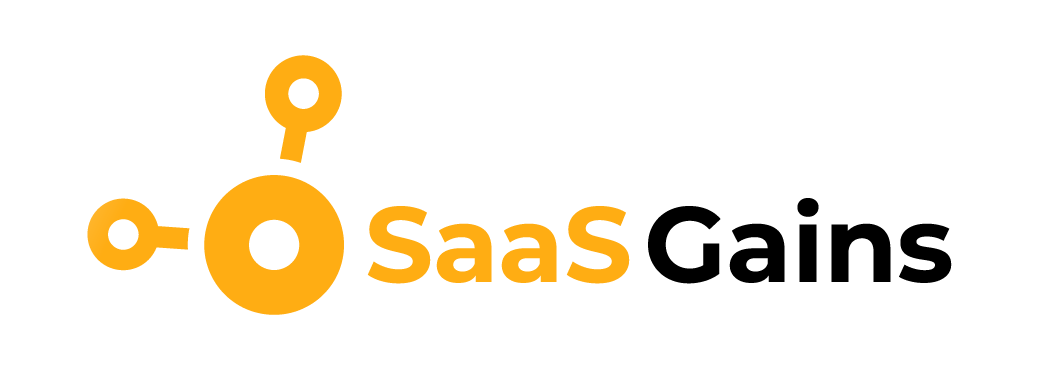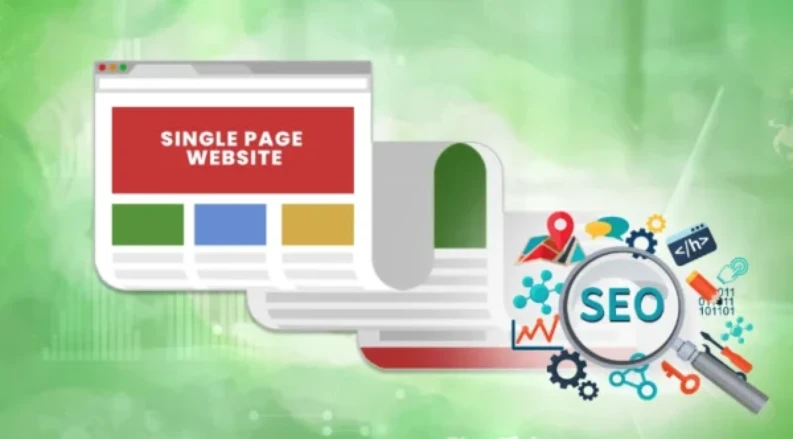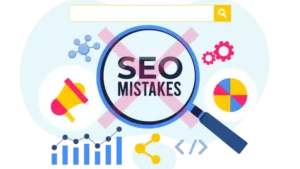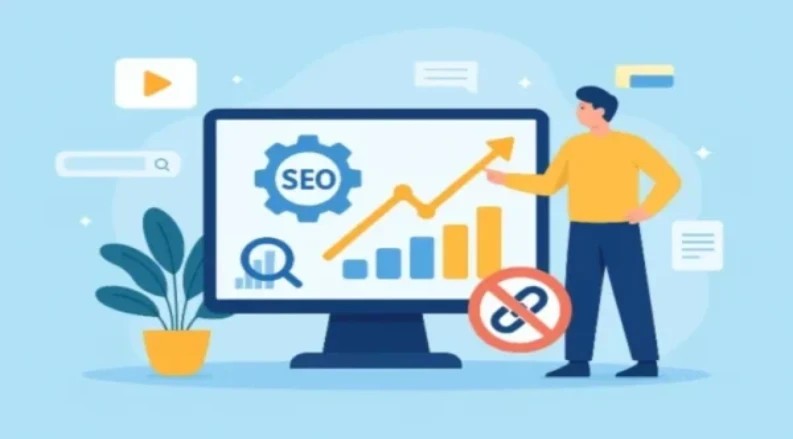Single-page sites are typically a piece of art. Their minimalist, sparse design, smooth scrolling, and focused user experience can be powerfully effective at telling a single, compelling story. But there is one question: do they really rank well on Google?
A lot of individuals believe that a multi-page website is the key to search engine optimization success. The reason being is straightforward: more pages equal more content, more keywords, and more chances to garner organic traffic. Although that is typically the case, choosing a one-page website does not guarantee that you will end up in a poor position.
This blog will demonstrate how to convert a one-page site, be it a product demo, startup landing page, or portfolio, into a fast, SEO-optimized site that merits a high search ranking. Let’s take a look at the most important single-page SEO tactics and demonstrate that great beauty and high ranking are not mutually exclusive.
Understanding Single-Page SEO
Single-page SEO is the purposeful practice of optimizing a single HTML page website, as compared to fragmenting pages like “About,” “Services,” or “Contact” into different URLs. It’s all on a scroll-length page. What that does is make it so that it takes a whole lot more thoughtful and intentional effort to optimize maximum potential from one URL for its particular search terms.
Key differences from conventional multi-page SEO
The biggest variance is in the way you keyword-target and organize your content. An average multi-page website can, theoretically, have an entire page dedicated to one service or topic, so it can rank for a very targeted and focused keyword. With a one-page website, you need to be even more careful with your writing and keywords, because all your topics need to get along under one URL. That is a tremendous understanding of how search engines view content context.
Biggest Challenges:
- Limited Keyword Targeting: The biggest limitation is that it can’t target multiple keywords. With only one URL and one title tag, you are forced to be very targeted in your keyword strategy, using a single root term and a group of closely related synonyms.
- Internal Linking Failure: Internal linking is a critical component of sharing authority and allowing search engines to notice the structure of your site more easily. With a single-page website, this is not something that happens automatically, so you have to rely on other signals in order to earn authority.
- Risk of Thin Content: A single-page website will contain very little content, and that will make it difficult for Google to comprehend the site’s intention and expertise. Thin content tends not to rank for competitive terms in general.
Why is it worth it?
- Improved Conversions: A linear, single-page experience is great at taking visitors to a straightforward call to action with fewer navigation distractions. This will result in improved conversion rates.
- Improved Loading Speeds: Fewer requests and files translate to these sites loading considerably faster, and this is a significant ranking signal for user experience. Fast websites also equal lower bounce rates.
- Better User Experience: The clean structure and easy scrolling could allow for a truly fascinating and engaged user experience, which will decrease bounces and inform Google that your site is useful.
Why SEO Optimize a Single-Page Site?
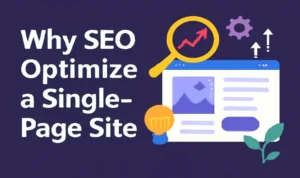
In our mobile-first society, UX and speed matter. The majority of modern-day startups, online portfolios, and SaaS landing pages are turning to one-page designs since they provide a speedy and convenient experience that users highly value. It dovetails with Google’s strategies of penalizing slow-loading websites that are not user-friendly. Your bounce rate will rise by 20% even if your mobile page loads more slowly by one second. You’re not merely pursuing rankings when you’re optimizing your one-page site; you’re also creating a quicker, more efficient, and improved online presence that leads directly to business results. Choosing deliberately to employ this new web design approach may have an enormous positive effect on organic visibility.
Step-by-Step Guide to Single-Page SEO
This is not a shortcut but an investment. Use the step-by-step guide to transform your one-page website into a search engine giant.
1. Smart Keyword Research

Your keyword research for a one-page website must be extremely targeted and intelligent. Don’t compete for ten or a dozen different keywords. Choose one base keyword that accurately defines your main business or service. This keyword will serve as your anchor theme for the page. Next, find a group of semantic keywords. They are semantically similar keywords and phrases that have the same user intent. Your keyword clusters are, for instance, “SEO for single-page websites,” “optimize single-page website,” and “single-page website SEO guidelines.” Use these terms organically in your copy to provide a complete response to the user’s question and demonstrate topical authority.
2. Organize Content with Clear Segments
Since you lack pages, you’ll need to take advantage of clean, well-delineated blocks so that both users and spiders can get around. A single block of copy is impossible and useless to read. Rather, utilize anchor-based navigation, which mimics a multi-page site structure. For instance, About / Services / Portfolio / Testimonials / Contact could be a healthy and typical hierarchy. Show your facts and organize your content in a reasonable flow. Add informative H2 and H3 headings within each category to demarcate the subjects each piece of content covers. Search engines can better understand and index portions of your page with this structured format, effectively at the subject level.
3. Meta Title and Description Optimization
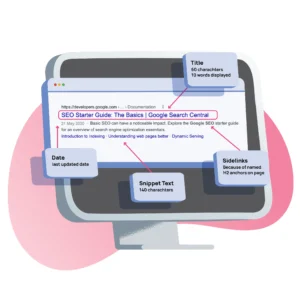 Your meta title and meta description are most deserving to receive search result clicks. Your meta title should be short, interesting, and include your primary keyword. Your meta description should serve as a page advertisement. It should include your primary keywords and some semantic keywords associated with it to indicate what the user will get in case of a click. An effective meta description ensures a proper solution to the user’s problem.
Your meta title and meta description are most deserving to receive search result clicks. Your meta title should be short, interesting, and include your primary keyword. Your meta description should serve as a page advertisement. It should include your primary keywords and some semantic keywords associated with it to indicate what the user will get in case of a click. An effective meta description ensures a proper solution to the user’s problem.
Example:
-
- Title: “Single Page SEO: Step-by-Step Optimization Guide (2025)”
- Meta Description: “Find out how to SEO optimize your single-page site with keyword targeting, anchor links, schema, and speed.”
4. Use Anchor Links to the Optimum for Better Navigation
Anchor links are those that lead a user to a specific part of the same page. These can prove to be very useful for a site spread over a single page.
Benefits:
-
- Enhances User Experience: They enable users to skip instant scrolling and directly jump to the content they are interested in without spending much time scrolling.
- Facilitates Google Crawling Sections: Every anchor is a standalone topic, which makes it possible for the algorithm to learn more about your content and even displays “jump to” links in the SERP. It provides your single page numerous entry points from the SERP.
5. Optimize On-Page Content and Keyword Positioning
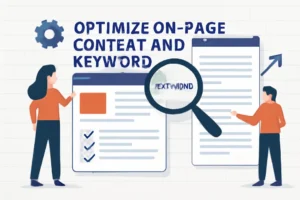
One-page website content that is quality, not quantity. Keyword stuffing, a huge error, is not to be tried. Rather, put your semantic keywords naturally within all sections. A great way to meet long-tail search intent is implemented by having a longer FAQ section responding to direct questions your users will have. Create engaging content with shorter paragraphs, bullet points, and high-quality images to maximize user dwell time. Your high-quality, well-written content constitutes the foundation of your SEO campaign.
6. Prioritize Speed & Mobile Optimization
This lovely one-page site would be wasted if it doesn’t load in a reasonable period on a mobile phone. With Google employing a mobile-first index, this is now no longer an option. You will then compress your pictures to maintain the file size as small as possible for the sake of loading your website faster. You might also minimize the CSS and JavaScript scripts and enable lazy loading, which loads images only when they are scrolled down by the user. Ensure your site is fast and bug-free by optimizing its speed and testing it with tools such as Lighthouse, GTMetrix, and Google PageSpeed Insights.
7. Add Instructive Media (Images, Video, Infographics)

High-quality media helps with telling the story and prolongs the dwell time of the user, both of which are great signals for search engines. It can break down bulky pieces of content and make your site more visually appealing, making it feel rich in information. When loading media, utilize keyword variants in descriptive alt text. This is beneficial for both Google and visually impaired individuals, making your images more accessible and providing another opportunity to reinforce your keywords and background, ultimately improving your overall SEO.
8. Establish Trust through Outbound and Backlinks
A single page is enough to establish authority. One critical element of your strategy is the inclusion of a few well-considered outbound links to authoritative, reliable sources, which helps to add value to your users. But above all, focus on getting quality backlinks from other sites in your niche. Powerful backlinks will inform Google that your website is credible and authoritative, and that’s a must to rank. It’s an off-page search engine optimization tactic that’s equally as important to a one-pager as a multi-pager.
9. Use Schema Markup
Schema markup is microdata that provides search engines with additional context for your content. It can help you claim rich snippets, which highlight your listing and are likely to generate greater click-through rates.
- Include the FAQ schema on your FAQ page so your questions appear in search results.
- Use the Local Business schema if you are a local company to include key information such as your address and opening times.
- Use the Product schema if you have a single item you’re selling in order to show ratings and price. The additions provide Google with structured data, which will help them sort and display your content correctly.
10. Monitor SEO Performance
What can’t be measured can’t be improved. Employ a battery of tools to monitor your progress and make decisions based on data.
- Google Search Console Rankings: Monitor your keyword ranking and organic traffic. Google Search Console will also notify you of technical problems.
- User behavior with Google Analytics: Monitor how users are behaving on your page, such as time on page and bounce rate.
- Heatmaps to observe where individuals are engaging with page regions: Viewing this visual information ensures you structure and write for the greatest interaction, retaining individuals on the page and tapping into the information they require.
Single-Page SEO Common Errors
- Keyword jamming because of limited space: Piling numerous keywords into limited space. This injures readability and may attract a penalty.
- Anchor links excluded: this is awful UX and complicates your site to navigate.
- No content richness: As Google is unable to scavenge enough text, it doesn’t know what the topic of your site is, so ranking is hard.
- Mobile UX and speed blindness: A beautiful one-page website doesn’t count if it is slow on a smartphone.
Expert Tips for Improving Single-Page SEO in 2025
- Make use of interactive design components like tabs, accordions, and sliders to present more content without making it appear cluttered. Consequently, you can provide more informative details without sacrificing the visual simplicity.
- Add case studies and reviews as social proof: To confirm credibility and trust, show this on the page.
- Remember to locally SEO optimize when selling to local customers. On your contact page, ensure that your business’s name, address, and phone number (NAP) appear in plain, clear English.
- Change occasionally: Even a one-page website can become outdated, so change it sometimes, include new reviews, or make the frequently asked questions section appear up-to-date.
FAQs
Can a one-page website rank for multiple keywords?
Yes, you can rank for your target keyword and a set of related keywords by discussing them naturally in various sections.
Is single-page SEO suitable for a small business?
It can be an ideal fit for companies that have one product or service.
Do anchor links affect SEO?
Yes, it enhances user experience and allows Google to consider each section as a unique topic.
How do I decide between single-page and multi-page websites?
Select a single-page website when your business is straightforward and a multi-page website when you have to rank for a number of keywords or your content library is extensive.
Conclusion
The single-page website myth that they don’t rank just isn’t true. With some smart keyword research, a content strategy, and technical SEO execution, you can turn your single-page website into a high performer. The key to success is hidden in the understanding of the natural barriers and taking advantage of the natural benefits of this type of design. Begin with cleaning up your content, making your site load faster, and implementing schema. Completing these steps will prepare you to advance to more advanced positions and generate more traffic.
